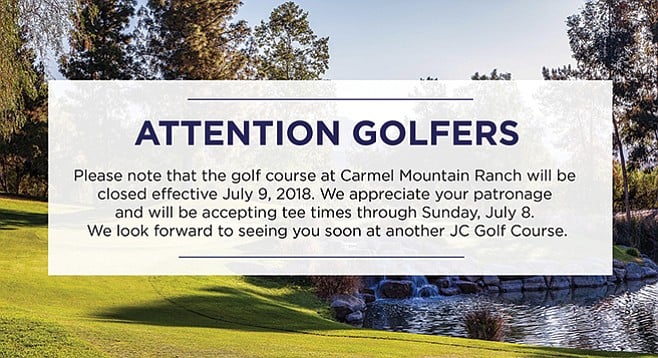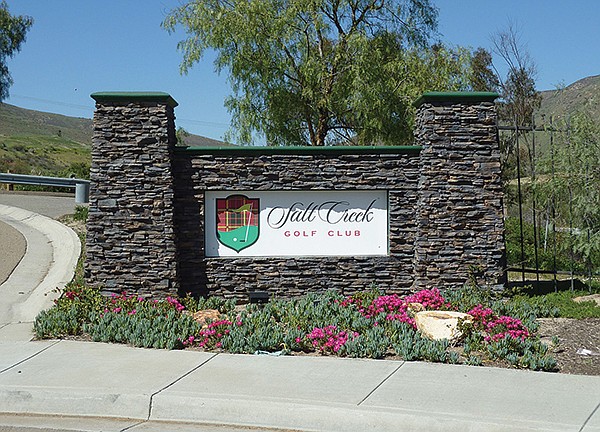 Facebook
Facebook
 X
X
 Instagram
Instagram
 TikTok
TikTok
 Youtube
Youtube

It was golf’s celebrated United States Open, played June of 2008, at Torrey Pines. The already weak national economy was about to go into a tailspin. Tiger Woods, the god of golf, was limping around Torrey Pines with a bad knee but remaining high on the leaderboard. He and Rocco Mediate, a mediocre pro golfer, went into a one-hole sudden death playoff, following an 18-round playoff. Woods won.

After his victory, Woods said he would miss the rest of the 2008 season because of that knee. The TV audience for the Torrey tourney had topped even the National Basketball Association finals. Without Tiger the rest of the year, it went into a huge slump. Soon, another major championship drew about one-third the TV audience drawn with Woods on the course.

Golf is critical to the local economy. San Diego is one of the nation’s great locations for golf courses. “When you think about golf in San Diego, chances are Torrey Pines — arguably the most renowned municipal golf course in the country — comes to mind,” enthuses Golf Digest, which ranks San Diego one of the 50 top destinations in the world. “But the natural beauty of this SoCal city doesn’t stop at the blue Pacific coast. Golfers who venture inland to canyon country will be rewarded with beautiful, challenging layouts.”

In recent years, several courses have gone into bankruptcy. Some courses have closed: Escondido Country Club, Chula Vista’s Salt Creek Golf Club, Carmel Highland Golf Course, Carmel Mountain Ranch Country Club, among them. The factors: decline in number of players; the high cost and shortage of water (even recycled water); high cost of labor; expensive (although receding) prices of equipment; the time it takes to play 18 holes on a standard course; and the lack of instant gratification. Golf takes patience and plenty of practice. It may not fit into our current culture.
San Diego is the capital of the world’s golf equipment manufacturing. Investor-owned Callaway Golf makes clubs, balls, apparel, and other items; TaylorMade is a leading club maker. Cobra puts out good clubs. Aldila makes shafts. Ashworth makes golf apparel.
But Callaway warns in its most recent annual report to the Securities and Exchange Commission, “If golf participation continues to decrease [italics mine] or the number of rounds of golf played decreases, sales of the company’s products may be adversely affected. In the future, the overall dollar volume of the market for golf-related products may not grow or may decline…the company may have limited opportunities for future growth in sales of golf clubs and golf balls.”
In the 1990s, overenthusiastic entrepreneurs built too many golf courses, and companies such as Callaway found they could charge $600 for one club, as their stocks zoomed into the stratosphere. The giddy futurists anticipated that the impending retirement of baby boomers would swell the number of people playing golf. But as the baby boomers retired, they found that it was too difficult and time-consuming to play a respectable game of golf. Golf courses went to seed, and the stock prices of equipment makers came back to earth, especially as it became obvious that while a space-age, exotic-metal club could add distance for a pro, it did little to nothing for a duffer.
After Tiger took the year off in 2008, golf participation, which had been in a downturn, sunk further. In 1990, according to Trib Total Media, there were 24.4 million golfers in the U.S. That grew steadily until it peaked at 28.5 million in 2004. Then it began sliding; 22.9 million in 2013 and 21 million now.
The National Golf Foundation paints a prettier picture, as you might expect from essentially a trade association for the industry. It says 23.8 million played last year, but others say it was only 21 million. The number of 2017 golf rounds was down 2.7 percent from the year earlier, concedes the foundation. The telltale statistic: 205 courses closed in 2017 and only 15 opened.
The foundation is now measuring the number of people playing golf off-course — at driving ranges and the like. The game Topgolf is the major draw off-course. It is such games as Topgolf that could bring in millennials (people born between 1981 and 1997). “But they are not particularly interested in golf,” says Jim Dunlap, San Diego–based managing editor of the publication put out by Pellucid Corp., the Chicago-based statistics aggregator that tracks golf numbers and trends.
However, Dunlap is recovering from surgery and asked me to go to Jim Koppenhaver, Pellucid’s chief executive. He addressed everything I wanted in an hour-long podcast that I listened to. Koppenhaver says he squirts “a bit of cold water” on rosy statistics. The number of golfers in 2017 moved “solidly sideways” from the previous year. It was only down 100,000 from 2016. “The rate of decline is slowing.”
Golf courses are only 52 percent utilized, compared with airlines’ 85 percent and hotels’ 80 percent. “Golf will never exceed 70 percent,” he says. Pellucid has a mathematical model for measuring playable hours — looking at weather, wind, etc. “We’re running 5 percent below our ten-year norm” in the United States.
The bottom line is that the golf industry is “six or seven years away from equilibrium,” he says. Equilibrium is the balance at which golf courses won’t have to battle to take market shares from other courses. Many more courses will have to die before equilibrium is struck. Investors in golf equipment stocks may have to wait for a big rally, although Callaway stock has doubled from earlier single-digit levels. On the other hand, in the rosy expectations era, Callaway traded in the mid-$30s, double where it now is.
“Golf needs to re-create the product,” says Koppenhaver. There is no way millennials can be attracted to the game. There may be ways that the game can be shortened in time. Four hours is a lot for a busy executive to give up. The shorter par-3 and executive courses have not been popular. Maybe more nine-hole games is the answer or rules to speed up play. Some suggest widening the hole. However, when people press for golf changes, the supercilious, rules-obsessed United States Golf Association often steps in. The industry has to loosen up.


It was golf’s celebrated United States Open, played June of 2008, at Torrey Pines. The already weak national economy was about to go into a tailspin. Tiger Woods, the god of golf, was limping around Torrey Pines with a bad knee but remaining high on the leaderboard. He and Rocco Mediate, a mediocre pro golfer, went into a one-hole sudden death playoff, following an 18-round playoff. Woods won.

After his victory, Woods said he would miss the rest of the 2008 season because of that knee. The TV audience for the Torrey tourney had topped even the National Basketball Association finals. Without Tiger the rest of the year, it went into a huge slump. Soon, another major championship drew about one-third the TV audience drawn with Woods on the course.

Golf is critical to the local economy. San Diego is one of the nation’s great locations for golf courses. “When you think about golf in San Diego, chances are Torrey Pines — arguably the most renowned municipal golf course in the country — comes to mind,” enthuses Golf Digest, which ranks San Diego one of the 50 top destinations in the world. “But the natural beauty of this SoCal city doesn’t stop at the blue Pacific coast. Golfers who venture inland to canyon country will be rewarded with beautiful, challenging layouts.”

In recent years, several courses have gone into bankruptcy. Some courses have closed: Escondido Country Club, Chula Vista’s Salt Creek Golf Club, Carmel Highland Golf Course, Carmel Mountain Ranch Country Club, among them. The factors: decline in number of players; the high cost and shortage of water (even recycled water); high cost of labor; expensive (although receding) prices of equipment; the time it takes to play 18 holes on a standard course; and the lack of instant gratification. Golf takes patience and plenty of practice. It may not fit into our current culture.
San Diego is the capital of the world’s golf equipment manufacturing. Investor-owned Callaway Golf makes clubs, balls, apparel, and other items; TaylorMade is a leading club maker. Cobra puts out good clubs. Aldila makes shafts. Ashworth makes golf apparel.
But Callaway warns in its most recent annual report to the Securities and Exchange Commission, “If golf participation continues to decrease [italics mine] or the number of rounds of golf played decreases, sales of the company’s products may be adversely affected. In the future, the overall dollar volume of the market for golf-related products may not grow or may decline…the company may have limited opportunities for future growth in sales of golf clubs and golf balls.”
In the 1990s, overenthusiastic entrepreneurs built too many golf courses, and companies such as Callaway found they could charge $600 for one club, as their stocks zoomed into the stratosphere. The giddy futurists anticipated that the impending retirement of baby boomers would swell the number of people playing golf. But as the baby boomers retired, they found that it was too difficult and time-consuming to play a respectable game of golf. Golf courses went to seed, and the stock prices of equipment makers came back to earth, especially as it became obvious that while a space-age, exotic-metal club could add distance for a pro, it did little to nothing for a duffer.
After Tiger took the year off in 2008, golf participation, which had been in a downturn, sunk further. In 1990, according to Trib Total Media, there were 24.4 million golfers in the U.S. That grew steadily until it peaked at 28.5 million in 2004. Then it began sliding; 22.9 million in 2013 and 21 million now.
The National Golf Foundation paints a prettier picture, as you might expect from essentially a trade association for the industry. It says 23.8 million played last year, but others say it was only 21 million. The number of 2017 golf rounds was down 2.7 percent from the year earlier, concedes the foundation. The telltale statistic: 205 courses closed in 2017 and only 15 opened.
The foundation is now measuring the number of people playing golf off-course — at driving ranges and the like. The game Topgolf is the major draw off-course. It is such games as Topgolf that could bring in millennials (people born between 1981 and 1997). “But they are not particularly interested in golf,” says Jim Dunlap, San Diego–based managing editor of the publication put out by Pellucid Corp., the Chicago-based statistics aggregator that tracks golf numbers and trends.
However, Dunlap is recovering from surgery and asked me to go to Jim Koppenhaver, Pellucid’s chief executive. He addressed everything I wanted in an hour-long podcast that I listened to. Koppenhaver says he squirts “a bit of cold water” on rosy statistics. The number of golfers in 2017 moved “solidly sideways” from the previous year. It was only down 100,000 from 2016. “The rate of decline is slowing.”
Golf courses are only 52 percent utilized, compared with airlines’ 85 percent and hotels’ 80 percent. “Golf will never exceed 70 percent,” he says. Pellucid has a mathematical model for measuring playable hours — looking at weather, wind, etc. “We’re running 5 percent below our ten-year norm” in the United States.
The bottom line is that the golf industry is “six or seven years away from equilibrium,” he says. Equilibrium is the balance at which golf courses won’t have to battle to take market shares from other courses. Many more courses will have to die before equilibrium is struck. Investors in golf equipment stocks may have to wait for a big rally, although Callaway stock has doubled from earlier single-digit levels. On the other hand, in the rosy expectations era, Callaway traded in the mid-$30s, double where it now is.
“Golf needs to re-create the product,” says Koppenhaver. There is no way millennials can be attracted to the game. There may be ways that the game can be shortened in time. Four hours is a lot for a busy executive to give up. The shorter par-3 and executive courses have not been popular. Maybe more nine-hole games is the answer or rules to speed up play. Some suggest widening the hole. However, when people press for golf changes, the supercilious, rules-obsessed United States Golf Association often steps in. The industry has to loosen up.
Comments